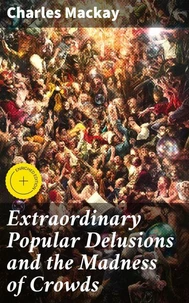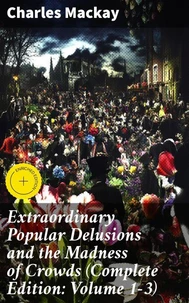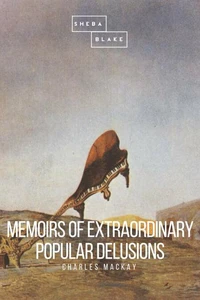The Psychology Behind the Madness of a Crowd
Par : , , , ,Formats :
Disponible dans votre compte client Decitre ou Furet du Nord dès validation de votre commande. Le format ePub est :
- Compatible avec une lecture sur My Vivlio (smartphone, tablette, ordinateur)
- Compatible avec une lecture sur liseuses Vivlio
- Pour les liseuses autres que Vivlio, vous devez utiliser le logiciel Adobe Digital Edition. Non compatible avec la lecture sur les liseuses Kindle, Remarkable et Sony
 , qui est-ce ?
, qui est-ce ?Notre partenaire de plateforme de lecture numérique où vous retrouverez l'ensemble de vos ebooks gratuitement
Pour en savoir plus sur nos ebooks, consultez notre aide en ligne ici
- Nombre de pages2503
- FormatePub
- ISBN859-65--4739236-1
- EAN8596547392361
- Date de parution13/11/2022
- Protection num.Digital Watermarking
- Taille6 Mo
- Infos supplémentairesepub
- ÉditeurDIGICAT
Résumé
In 'The Psychology Behind the Madness of a Crowd, ' readers are introduced to a compendium of influential reflections on the behavioral phenomena that define collective human behavior. This anthology traverses the rich terrain of crowd psychology, drawing from a diverse array of literary styles and historical perspectives. The included works, spanning essays to philosophical treatises, probe the intricate dynamics of societal and psychological undercurrents that characterize human congregations.
The collection achieves a dynamic tapestry of thought, illuminating how groups often transcend individual rationality, resulting in behavior as captivating as it is sometimes perilous. The authors within this anthology are seminal voices who have shaped our understanding of collective psychology. With contributions from luminaries such as Charles Mackay, Gustave Le Bon, and Wilfred Trotter, the collection draws from thinkers associated with various historical and cultural movements, from the Enlightenment to early 20th-century psychology.
These minds converge to dissect the elemental forces at play in group dynamics, offering nuanced insights into the moral and societal implications of mob behavior. Through their essays and theories, they invite readers to explore the psychological mechanisms that transform rational individuals into powerful, and occasionally irrational, collective entities. This anthology is an essential acquisition for anyone keen to unravel the complexities of crowd behavior, offering a rare opportunity to engage with a multitude of perspectives and analytical styles within a unified theme.
It is an invaluable resource for scholars, students, and lay readers alike, seeking to understand the socio-psychological fabric of crowd phenomena and its impact throughout history. By immersing oneself in this compilation, readers will be propelled into a dialogue that is as enlightening as it is thought-provoking, expanding their comprehension of how individual psychology is reshaped in the crucible of the crowd.
The collection achieves a dynamic tapestry of thought, illuminating how groups often transcend individual rationality, resulting in behavior as captivating as it is sometimes perilous. The authors within this anthology are seminal voices who have shaped our understanding of collective psychology. With contributions from luminaries such as Charles Mackay, Gustave Le Bon, and Wilfred Trotter, the collection draws from thinkers associated with various historical and cultural movements, from the Enlightenment to early 20th-century psychology.
These minds converge to dissect the elemental forces at play in group dynamics, offering nuanced insights into the moral and societal implications of mob behavior. Through their essays and theories, they invite readers to explore the psychological mechanisms that transform rational individuals into powerful, and occasionally irrational, collective entities. This anthology is an essential acquisition for anyone keen to unravel the complexities of crowd behavior, offering a rare opportunity to engage with a multitude of perspectives and analytical styles within a unified theme.
It is an invaluable resource for scholars, students, and lay readers alike, seeking to understand the socio-psychological fabric of crowd phenomena and its impact throughout history. By immersing oneself in this compilation, readers will be propelled into a dialogue that is as enlightening as it is thought-provoking, expanding their comprehension of how individual psychology is reshaped in the crucible of the crowd.
In 'The Psychology Behind the Madness of a Crowd, ' readers are introduced to a compendium of influential reflections on the behavioral phenomena that define collective human behavior. This anthology traverses the rich terrain of crowd psychology, drawing from a diverse array of literary styles and historical perspectives. The included works, spanning essays to philosophical treatises, probe the intricate dynamics of societal and psychological undercurrents that characterize human congregations.
The collection achieves a dynamic tapestry of thought, illuminating how groups often transcend individual rationality, resulting in behavior as captivating as it is sometimes perilous. The authors within this anthology are seminal voices who have shaped our understanding of collective psychology. With contributions from luminaries such as Charles Mackay, Gustave Le Bon, and Wilfred Trotter, the collection draws from thinkers associated with various historical and cultural movements, from the Enlightenment to early 20th-century psychology.
These minds converge to dissect the elemental forces at play in group dynamics, offering nuanced insights into the moral and societal implications of mob behavior. Through their essays and theories, they invite readers to explore the psychological mechanisms that transform rational individuals into powerful, and occasionally irrational, collective entities. This anthology is an essential acquisition for anyone keen to unravel the complexities of crowd behavior, offering a rare opportunity to engage with a multitude of perspectives and analytical styles within a unified theme.
It is an invaluable resource for scholars, students, and lay readers alike, seeking to understand the socio-psychological fabric of crowd phenomena and its impact throughout history. By immersing oneself in this compilation, readers will be propelled into a dialogue that is as enlightening as it is thought-provoking, expanding their comprehension of how individual psychology is reshaped in the crucible of the crowd.
The collection achieves a dynamic tapestry of thought, illuminating how groups often transcend individual rationality, resulting in behavior as captivating as it is sometimes perilous. The authors within this anthology are seminal voices who have shaped our understanding of collective psychology. With contributions from luminaries such as Charles Mackay, Gustave Le Bon, and Wilfred Trotter, the collection draws from thinkers associated with various historical and cultural movements, from the Enlightenment to early 20th-century psychology.
These minds converge to dissect the elemental forces at play in group dynamics, offering nuanced insights into the moral and societal implications of mob behavior. Through their essays and theories, they invite readers to explore the psychological mechanisms that transform rational individuals into powerful, and occasionally irrational, collective entities. This anthology is an essential acquisition for anyone keen to unravel the complexities of crowd behavior, offering a rare opportunity to engage with a multitude of perspectives and analytical styles within a unified theme.
It is an invaluable resource for scholars, students, and lay readers alike, seeking to understand the socio-psychological fabric of crowd phenomena and its impact throughout history. By immersing oneself in this compilation, readers will be propelled into a dialogue that is as enlightening as it is thought-provoking, expanding their comprehension of how individual psychology is reshaped in the crucible of the crowd.






